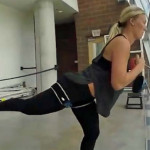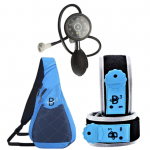"Blood Flow Restriction Bands (BFR Bands) are designed and constructed with high-quality concepts to deliver many, many hours of benefits," stated Dr. Mike DeBord, president of B3 Sciences, Inc. "Quality design and quality construction ensure safety and deliver verifiable results. Blood Flood Restriction Bands have become an important part of any BFR workout. In addition, we are seeing BFR Bands being used by physical therapists during physical therapy sessions".
Do BFR bands work?
Yes. Every month there seems to be another study or testimonial about Blood Flow Restriction Bands. Some of the US Olympic teams are using BFR bands during training. Professional football and soccer teams use BFR bands to improve physical performance and speed recovery from injuries. BFR Bands have arrived, and they are becoming permanent tools for athletes and ordinary people who want better workout results in less time.
Blood Flow Resistance training (BFR training or BFRT) is also called BFR occlusion training. The BFR Bands wrap the arms or legs during exercise or strength training. The bands limit blood flow to the arm or leg muscles and put the forces under considerable stress. The result is that the muscles adapt, get stronger, and in the process, produce natural growth hormones. Natural growth hormones have multiple benefits for the human body, including an increase in muscle mass, a reduction in body fat, faster healing, and overall better health. To learn more about the BFR band's work, click the video below.
What Should I Look For In BFR Bands?
The first thing to look for in BFR Bands is quality. Low prices usually equate to low quality. The design of the bands is one key. BFR bands restrict blood flow; they do NOT cut it off completely. Avoid products that are tourniquets - tourniquets are used for major traumatic injuries. High-quality BFR Bands have multiple chambers that make it almost impossible to cut blood flow by accident or intention completely. The materials of the BFR bands should be durable and water-proof to repel both sweat and water when swimming. BFR bands should also be available in different sizes for all age groups. And finally, BFR bands should have a mechanism to easily and accurately increase and decrease the pressure being exerted by the bands.
Are BFR bands bad for you?
"I have seen and read about the misuse of some of the lower quality BFR bands and tourniquets that are being marketed as BFR bands. Some of these devices are very narrow in width and apply too much pressure on a small muscle area, which can be painful and risk injury. Other tourniquet-like devices, such as belts and straps that you can purchase online, are not BFR bands and should not be used. Additionally, I have read about training protocols not being followed. A lot of the misuse boils down to common sense. Finally, BFR should not be painful. If the device is causing the user pain, they are probably using an inferior BFR device or simply not following the directions, and they should stop what they are doing," stated Dr. DeBord.

Why is BFR bad?
BFR is NOT bad. BFR bands have been studied and tested in a variety of countries and under a variety of conditions with both athletes and non-athletes. The results are overwhelmingly positive. Professional and Olympic athletes use blood flow restriction bands for training and injury rehabilitation. Physical Therapists are using BFR bands with their patients because they don't require lifting weights and can be done in less time. BFR bands, like any piece of exercise equipment, can be misused.
Leading Causes Of BFR Band Misuse
- Low-quality bands that apply too much pressure to a small area of the muscle
- Using tourniquets - they are not high-quality BFR bands
- Failure of the user to follow instructions
- Failure of the user to use common sense
Do BFR bands work for butt?
BFR bands deliver a marvelous workout for the glutes. Everybody wants a nicely toned bum and women have been particularly impressed with the results from BFR bands for glutes. Blood Flow Restriction Training for glutes doesn't occlude the glutes directly. However, the BFR bands are placed on the upper thigh between the hamstring and the glutes, which creates an isolation exercise for the glutes. Consistent glute workouts with BFR bands will increase both strength and muscle size in the glutes and legs.
Dr. DeBord is the President of B3 Sciences, Inc. His company specializes in providing easy-to-follow videos and life coaching to his customers and clients. “Once people experience BFR Bands, they rarely go back to the old, long and hard way of exercising!" he stated.


























